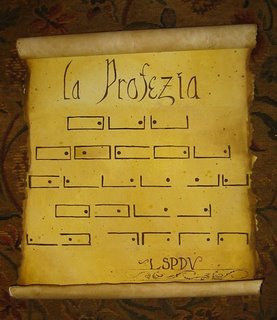Sunday, May 21, 2006
Professor, author of Sacred Feminine book, discovers ancient parchment signed by Da Vinci
2 comments
 Robert Langdon, professor of Religious Symbology at Harvard University in Cambridge, Mass., has been a busy man lately. His expertise includes classical iconology, symbols of pre-Christian culture, goddess art, and the decryption of ancient ciphers. He is he author of over a dozen books, including The Symbology of Secret Sects, The Art of the Illuminati, The Lost Language of Ideograms, as well as a college textbook of Religious Iconology.
Robert Langdon, professor of Religious Symbology at Harvard University in Cambridge, Mass., has been a busy man lately. His expertise includes classical iconology, symbols of pre-Christian culture, goddess art, and the decryption of ancient ciphers. He is he author of over a dozen books, including The Symbology of Secret Sects, The Art of the Illuminati, The Lost Language of Ideograms, as well as a college textbook of Religious Iconology.Recently, while working on his latest project, an exploration of modern religious iconography and its origins in the ancient goddess cults book called Symbols of the Lost Sacred Feminine, Professor Langdon discovered an ancient parchment that historians now believe may be the work of Leonardo da Vinci. The parchment seems to be signed by da Vinci; it bears the initials LSPDV. Leonardo's full name was Leonardo Ser Pieri Da Vincio.
The parchment bears a title: La Profezia, or The Prophecy. Just before Leonardo died, according to legend, he made a powerful prophecy about the future. Prof. Langdon and other historians believe this parchment may be the key to Da Vinci's long lost prediction, encoded in a key consisting of 24 symbols. The professor also believes this key was not original to Da Vinci, but reproduced by him from an earlier papyrus first found in Jerusalem, in the Middle Ages, and may have been created around 1000 B.C., during the reign of King Solomon.
Read more about Professor Langdon and his research on his website.
A related article discusses other tangents involving this Solomon Key, including possible ties to the New World — America — including modern Freemasonry and recently built granite and marble monuments such as those in Washington, D.C. and the mysterious Georgia Guidestones in Elberton, Georgia.
Robert Langdon | King Solomon | Solomon Key | Da Vinci Code | Dan Brown | Leonardo da Vinci | Film | Movies | Sacred Feminine | Religious Symbology | LSPDV | La Profezia | The Prophecy | The Symbology of Secret Sects | The Art of the Illuminati | The Lost Language of Ideograms | Religious Iconology | Symbols of the Lost Sacred Feminine | Ancient Goddess Cults | Freemasonry | Masons | Georgia Guidestones
Comments:
<< Home
In reference to the recipe:
Arrogance and Competitiveness? I suppose George Bush would rank high on your definition of sacred fem.
Post a Comment
Arrogance and Competitiveness? I suppose George Bush would rank high on your definition of sacred fem.
<< Home



